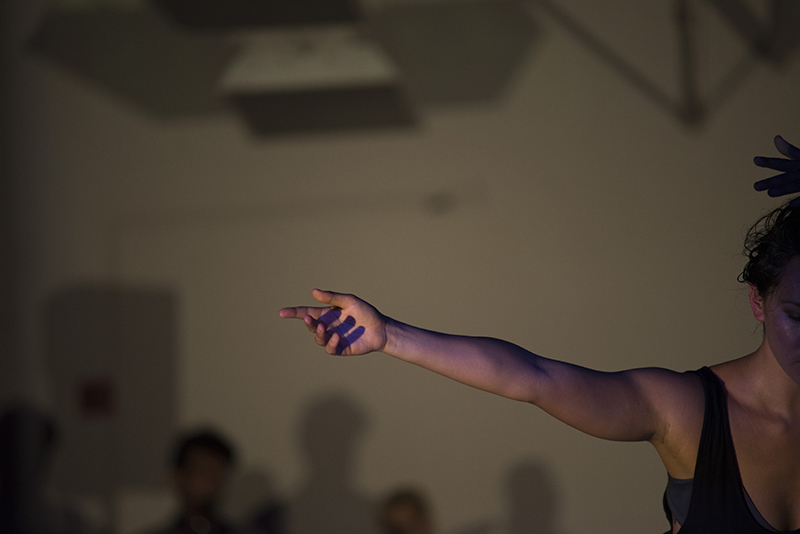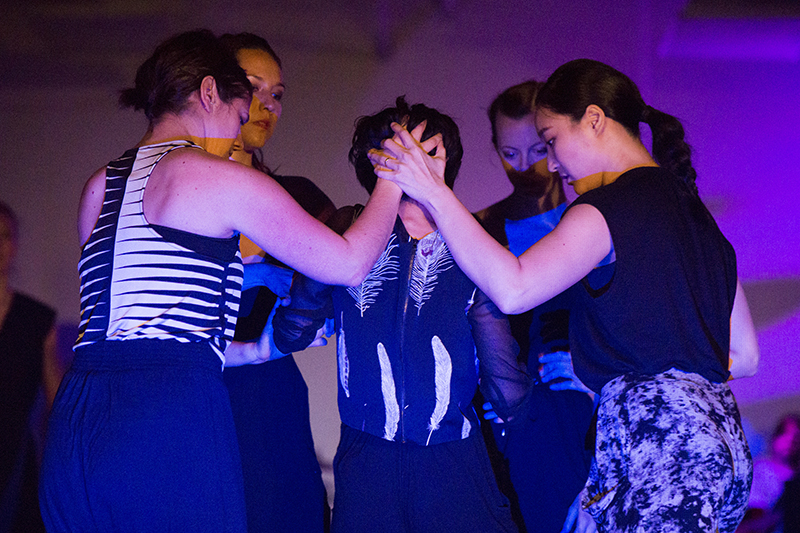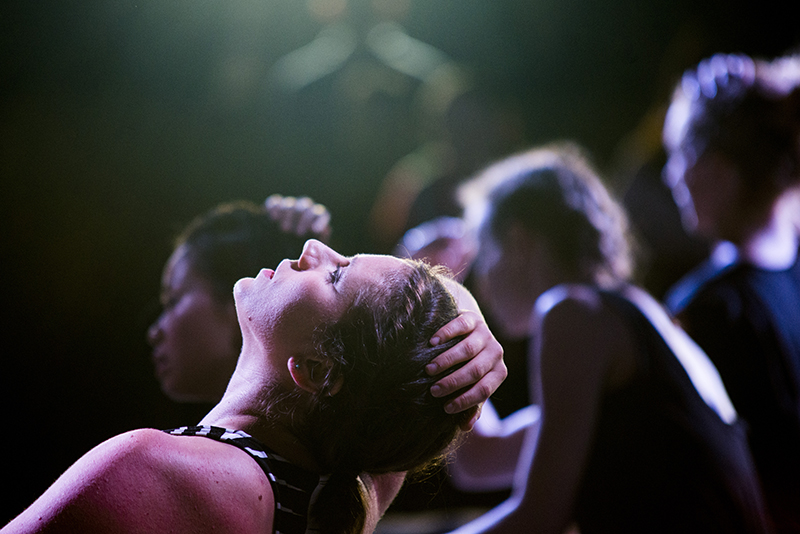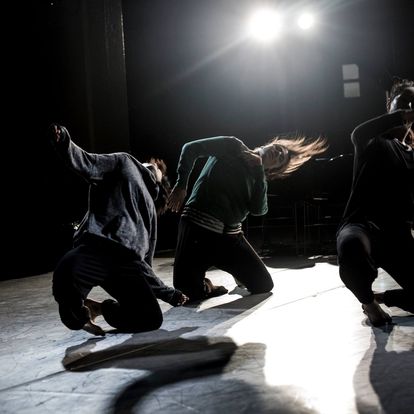Finding the Response
An Interview with Christine Cali and Farrah McAdam
BY EMMALY WIEDERHOLT
Christine Cali is the choreographer and director of CALI & CO in the San Francisco Bay Area since 2001 and the Chair of the Department of Theatre Arts and Dance at Sonoma State University. Farrah McAdam is a longtime collaborator with Christine and is also on faculty at Sonoma State. Here, they discuss their upcoming piece, PERFECT.RESPONSE., a two-part collaboration with musician The Welcome Matt that explores perfectionism and its impacts on the individual and collective body, seeking to dismantle notions of standards and norms, and researching the space between stimuli and response.
PERFECT.RESPONSE. will be performed in San Francisco at the Joe Goode Annex from November 30th through December 2nd. Learn more here.

Photo by Myray Reames
~~
Can you tell me a little about your dance history – what kinds of performance practices and in what contexts have shaped who you are today?
Christine: I’ve been in the Bay Area making dances since 1998. I came out here after undergrad at Ohio University; I grew up in Niagara Falls, NY, Iroquois land. I started teaching right away. I built the company’s offerings over time. I have built workshops, open classes, and performances that are collaborative and multi-disciplinary for the past 25 years. During this time, I was invited for several residencies and visiting artist and professor positions, most notably at Sung Kyun Kwan University in Seoul, South Korea (2006-08’).
I’m currently the Chair of the Department of Theatre Arts and Dance at Sonoma State, which has given me space for a lot of scholarship and allowed me to dive into diversity, equity, inclusion, access, and belonging. As an educator, scholar, and dance-maker, building relationships first and deepening relationships throughout is important in my upcoming work and in the trajectory of my career.
From 2017 to present day, I’ve been in collaboration with Urban Bush Women (UBW), first as an invitation to the company for a residency at Sonoma State. That turned into an invitation to collaborate and perform with the company in their work Hair and Other Stories, which has toured the country. Their work has been substantial in my process around accountability and transparency: How might we navigate dance-making as resistance and as radical action? In my creative work today, I am investigating how we can be in care as we’re simultaneously dismantling processes that have been harmful, so that our practices are not reiterating harmful cycles.
Farrah: I grew up in Southern California and completed my undergrad at Sonoma State. That’s where I met Christine. From 2010 to the present, what Christine has shared has become a core of my personal journey from professor to mentor, to colleague and friend. In 2017, I started working with CALI & CO. I also have been in relationship with UBW and their Summer Leadership Institute, attending two SLIs and assisting with CSU Summer Art’s course with UBW in Summer 2022, which Christine coordinated. Christine has had a huge impact on how I think about art as resistance, liberation, and joy. I’m navigating my personal way of how I like to do that. It’s a big challenge and responsibility and takes a lot of internal navigating but is so worth it. Anywhere Christine goes, I want to follow.
How would you generally describe your work to someone unfamiliar with it?
Christine: I have a process I’ve been facilitating called practice to performance, which is for anyone interested in embodied practice and creative processes for expression. We usually do a weekend workshop, perform what we create, stream it together with transitions, and we have an evening length work in two days. This is a quick turnaround, for sure, but I have discovered, now having taught nearly 25 of these workshops, it is possible to go deep in process when honoring and amplifying participants’ lived and embodied experience. They are the experts of their bodies, experiences, and expression. I always start with a warmup and tuning in, a tracking of self. Then we move into relational work, seeing, breathing, and witnessing each other. We get into the dynamics of choreography and rhythm, but it lives a lot in improvisation, self-reflection, and then dialogue. And then we go deeper. We might write about it. I look at the overall arc of the work and help to shape the concept and flow. I sense a lot of trust in the room which allows me to direct and shape the vision.
Recorded voice or live text is huge for me. I am invested in shaping context in contemporary dance. That’s a personal preference and philosophy; I don’t want to leave people lost and wondering what they are seeing. That doesn’t mean I don’t love abstraction. But I’m interested in the authentic exploration of who a person is in the context of ideas, and how I can invite audience in, to feel a part of it, included. Dance can be so exclusive, and I am not interested in that.
And I’d be remiss if I didn’t mention live music. I’m in a personal relationship with Matt Langlois of the longtime band, The Welcome Matt. He is also the music director for CALI & CO. Over the past decade, that has given me possibility and evolution/revolution that wasn’t there before. Working with original music and sound and being in collaboration with live musicians has been just so incredibly expansive and transformative.
Farrah: I want to add that because of the way Christine works, in a relational way, their work always has a crackling energy and is very much alive. A lot of dance often feels polished and packaged. It’s not that we can’t deliver that, but we intentionally leave space and opportunity for the work to adapt to every performance as we’re responding to the energy we’re receiving from the audience or from what transpired that day.

Photo by Myray Reames
Can you tell me about your upcoming performance, PERFECT. RESPONSE., and how the piece came about?
Christine: I have been in deep work and training, undoing and reimagining around anti-racism and anti-oppression, which I have been navigating for a long time but became much more acute with #MeToo and the murder of George Floyd. Becoming the Chair of a department meant more accountability and responsibility. In this arrangement, I started to notice more the white supremacist and hierarchical structures, beyond my personal and inter-relational experiences navigating them. I was looking to cultivate healthier workplaces in my leadership role.
I noticed that I was nervous about responding in a certain way, rewriting emails over and over again, overly preparing for things because I didn’t want to make a mistake. That became amplified being in a leadership position and I began to see it in other people, and often women. I began to ask: Can we unravel that piece on a personal and societal level? How might we respond differently or give ourselves time to respond and not be fearful about how our responses might land?
That’s where I started. I made PERFECT in collaboration with Sonoma State students this past spring 2023. One of those students graduated and is performing in this current work, as well as several alums.
Farrah: I was wondering, Christine, if NOISE, another piece you made, was also a catalyst?
Christine: Absolutely. Do you want to speak to it? You were part of that process.
Farrah: It was a trio with Christine, me, and Kristen Daley. We were all teaching at Sonoma State and navigating leadership spaces and systems we’re a part of. There’s so much noise, so many meetings and emails where people are talking at each other or talking forever. NOISE felt like a way to process and challenge the noise around us and what we do with it. What is the truth, what is our truth, how much do we really need to hear?
Christine: One other inspiration has been a book I’ve been reading called The Myth of Normal: Trauma, Illness, and Healing in a Toxic Culture by Gabor Maté. It’s been life altering to read this book while we’re working on this piece.
What has your work process been like?
Christine: Co-creation, even more so than in the past. It has taken me out of my formula, which was pretty open to begin with. This emergent way of working makes it feel easy to share the work out in the world, because it’s about all our stories and voices, and not just about me bringing a concept and having people funnel their ideas through it. New knowledge and wisdom are arriving, and we take it and go. It’s also why I was hoping Farrah would join this interview, because it’s beyond what my perspective is on the work. We’re not just performing for people; we’re opening dialogue, whether that’s words or physical sharing of space.
Farrah: I feel that Christine’s way of working is the place of my greatest growth. As a performing artist when I’m asked to be in a work, there’s often this built-in expectation: here’s what the piece is about, or here’s the movement, and your role is to learn, embody, repeat. I’ve been conditioned to perform in that way, and Christine is always dismantling that. Instead, it’s: “I want you in the process because of who you are and what you express.” It reveals how much I, and others, have been conditioned to respond “perfectly” rather than truthfully and authentically.

Photo by Myray Reames
What is the “RESPONSE” part of the piece?
Christine: We’re still deep in finding the second part of the work. That’s the harder space. Many of us know how we’ve been harmed or how social constructs keep us in boxes or wounded on the edges of those boxes. Dismantling that is physical work – it’s sharp and broken. Getting into the response, the healing, is leading to audience engagement and finding some joy and liberation. What does a liberated body feel like with a group of people? What I’m tracking right now is it’s becoming less performative and less theatrical. There’s some luscious powerful dancing in this last section. In contrast, the PERFECT part has a lot of specificity.
I’m okay being seen making mistakes, not-knowing, but so many people struggle with that. I model that as a leader and as a teacher. I show up where I’m at. It means being vulnerable and authentic. It means taking risks and being brave. It means trusting yourself. That’s where this response part is headed.
Farrah: First response: I love it. It makes me think about what Christine says about being vulnerable and being brave. The RESPONSE section is about us being even braver, even more vulnerable. We are in direct response with each other. That section is really moving and shifting and alive. It’s less of a performance and more of us being together in real-time. I feel more sensing and tuning, and I do feel braver. All this work that Christine has laid down has allowed us to tap into our humanness.
What do you hope audiences take away from PERFECT. RESPONSE.?
Christine: A sense of worthiness, value, agency, possibility. I think that dance, theater, and live music not only serve to channel and funnel the impacts of life, they are also anchors, and change-makers. It’s more than performance. Building relationships is possible and necessary. I hope audience members leave feeling there’s less of a hierarchy of excellence or professionalism, and that we all are valuable as we are in this moment. You are a part of the larger picture, not just your own picture. Being brave and vulnerable allows space for connection. No one can live life alone. We need each other. We need community. We need to feel held and cared for, especially as we adult-up.
Farrah: One phrase that I’ve carried from my times with UBW is that the genius is in the room, and Christine does a genius job of letting that live and thrive in the spaces they curate.
I don’t want to call them audiences – maybe participants? I hope they feel called to the table, and that this offering helps them remember that we are more than one-dimensional “roles”. That’s what makes humans cool and complicated. The complication is what we need to acknowledge and celebrate. I hope it leads the audience to be inspired and motivated to engage and connect with their worlds more often and more deeply.
Any other thoughts?
Christine: Some spaces and places that have given me containers to learn, grow, and practice, toward less harm, more healing as an artist-educator: Academics for Black Survival and Wellness, SpeakOut in Oakland, UBW of course.
Farrah: There are many individuals and collectives who are implementing these same reimaginings and pushing for something better. Latanya Tigner and Ebonie Barnett at Dimensions Dance Theater, Intangible Roots, Destiny Arts Center, peers like Veronia Jiao, Ruby Morales, Coley Curry, Maggie Waller whom I have come to know through the UBW community, the entire faculty at Rennie Harris University where I’m currently working on a teaching certification: Rennie Harris himself, Dr. Ayo Walker, Nubian Nené, Paula Webster, Olivia O’Hare, Larry Love and many more. Once you commit to the practices of dismantling and reimagining, you start to find yourself in the networks that are pursuing the same. And you are more interconnected than you know!
Christine: I want to add that this work is collaboratively created and co-authored. Each collaborator has agency for what they share in this process and authorship of their contributions for their future or concurrent personal and/or professional endeavors.

Photo by Myray Reames
~~
Learn more about CALI & CO at calidances.com.
